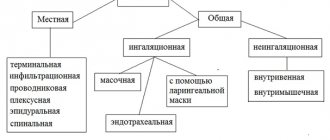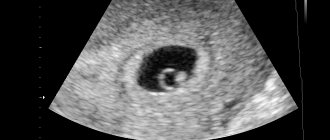Why the embryo does not attach to the uterus is the main question of a woman going through IVF. The implantation process is considered the most difficult in all artificial insemination and it is to this that doctors pay great attention. Statistically, pregnancy with IVF occurs only in 30% of cases.
Fertilization is the first process in the IVF technique. After this comes the main and final stage - the attachment of the embryo to the wall of the uterus. It depends on this process whether a woman’s desire to become a mother becomes feasible, and whether the doctors’ work was successful. After all, if implantation does not occur, all efforts will be in vain. The thing is that at this stage it is not known whether the blastocyst will remain at the bottom of the uterus or will come out with menstruation. Success does not depend on the desires of the woman or the efforts of the medical staff. The main task during embryo attachment is not to create difficulties for the mechanism of interaction between the intended fetus and the mother’s body.
Symptoms of successful implantation
Unfortunately, there are no obvious symptoms that the embryo has implanted in the uterus.
In rare cases, a woman may have slight discharge and pain in the lower abdomen, but these symptoms are short-lived. Basically, the fertilized egg implants painlessly and almost imperceptibly. Heavy bleeding and acute pain indicate hormonal problems and require immediate consultation with your doctor. They interfere with the normal development of pregnancy and require increased medical attention. During the process of attachment of the fertilized egg to the uterus, a woman may be irritable, emotional and feel a slight weakness in the body.
In order for the embryo to attach, the woman must follow all the doctor’s recommendations. A successful result is the correct interaction and mutual understanding between the doctor and the patient.
Symptoms after embryo implantation
After implantation of the embryo into the uterine cavity and its attachment to the walls of the uterus, the first symptoms that indicate pregnancy will occur are spotting dark discharge (not bloody), emotional instability, dizziness and nausea. For many women, the symptoms are smoothed out, a slight temporary discomfort occurs, which quickly passes. Basal temperature may rise, which also indicates pregnancy. After embryo implantation during IVF, a pregnancy-confirming result can be obtained within 10 to 14 days. First, a pregnancy test is performed. If the test does not show a positive result, you should be tested for hCG (human chorionic hormone). The level of this hormone in the blood increases during pregnancy.
Advice for expectant mothers
During embryo implantation you should:
- limit yourself in physical activity, forget about sports and heavy bags for a while;
- completely limit sexual intercourse;
- try not to visit crowded places;
- eat well and properly;
- do not freeze;
- get enough sleep;
- do not be nervous and limit yourself from stress and depression;
- exclude hot baths, saunas and baths;
- give preference to clothes that do not restrict movement;
- wear shoes without heels;
- Avoid taking medications other than those prescribed by your doctor.
About 10 days after the embryo was implanted into the uterus, the woman should be very careful about herself, her own behavior and daily routine.
The embryo does not attach to the uterus: causes and sensations
Under favorable conditions, seven days after fertilization of the egg, pregnancy occurs.
But, in some cases, this may not happen, due to the fact that implantation of the embryo did not occur. Expectant mothers are interested in why the embryo does not attach to the uterus and what are the reasons. For pregnancy to occur, the fertilized egg must develop into a zygote and implant in the uterus. After this, it can be considered an embryo. In order for an embryo to take root in the uterus, its walls must be ready to receive it.
According to doctors, conception can be early or late.
With early implantation, which occurs no later than seven days after ovulation, the female body is not yet prepared to receive the embryo; the endometrium does not have the required thickness. But such cases happen infrequently.
Late attachment usually occurs on the tenth day after fertilization. This period is considered the most favorable when carrying out the IVF procedure.
If, at this time, the woman’s body perceives the embryo as a foreign body, the embryo may not attach to the uterus, rejection will occur and menstruation will occur. A woman is considered pregnant after the implantation and consolidation of the fertilized egg in the uterus. This takes from one to three days.
In the protocol, the future embryo develops outside the female body, it is implanted when it is already mature, and it is able to take root faster than in a natural pregnancy. This is the difference between IVF and natural conception. Embryos aged 3–5 days have the highest survival rate.
With artificial insemination, pregnancy does not occur in all cases. In order to determine why there is no implantation, doctors find out all the reasons for the embryo not attaching to the uterus during IVF. Sometimes, the egg does not attach to the uterus and conception does not occur.
The reasons for unsuccessful embryo implantation are:
- the presence of endometriosis, fibroids;
- too thick or thin layer of the endometrium, the thickness of which is ideally from 10 to 13 millimeters;
- a large number of abortions;
- genetic abnormalities in the embryo that do not allow it to attach;
- low levels of the hormone progesterone, which is responsible for creating conditions for fetal development.
Compliance with the last point is of no small importance.
For 12-14 days after the transfer, the woman is advised to follow a gentle regimen, avoid physical activity, and avoid stressful situations.
Lack of implantation during IVF:
- low-quality biomaterial;
- pathological changes in the endometrium;
- hydrosalpinx tubes;
- unqualified support during the protocol;
- ignoring doctor's orders.
What happens if the embryo does not attach to the uterus? If the fertilized egg does not attach, the so-called spontaneous termination of pregnancy occurs at a very short time. Sometimes, a miscarriage occurs after implantation, when the body begins to produce the pregnancy hormone and the test shows a positive result.
The beginning of the natural implantation period is considered to be the time when an embryo with at least 16 cells enters the wall of the uterus and the egg enters the mucous membrane.
The attachment of the fertilized egg in the protocol differs from natural conception in that it is more quickly implanted.
How the embryo attaches to the uterus during IVF:
- in the first two days, a zygote is formed from the oocyte, from which an embryo has four cells by the end of the second day;
- on the third day there are already eight cells, the embryo is ready for transfer, but the likelihood of pregnancy due to its immaturity is low, and further cultivation occurs to the blastocyst stage, which occurs on the fifth day. This period is considered the best for transfer;
- after replantation, within 48 - 72 hours, under favorable conditions, the fertilized egg attaches to the walls and begins to grow, as in a natural pregnancy. But, in order for this to happen, the embryo itself must have the ability to further develop.
It is possible to transfer the blastocyst to the uterus at the age of 2-4 days, but this is impractical, and the chances of a successful pregnancy are low. After implantation, you need to wait at least two weeks to confirm a positive result.
The fertilized egg is attached in different places. If the embryo is attached high in the uterus, it means that it has implanted close to its bottom, which is the most favorable for its further development. If the embryo does not attach, another menstruation occurs, and the fertilized egg is released along with the discharge.
Many patients who have entered into the protocol are interested in the question of why the embryo does not attach to the uterus during IVF. This is influenced by many factors, to eliminate which additional treatment is carried out, increasing the chances of a successful transfer.
The reason that the fetus has not implanted may be poor quality of the endometrium with increased or decreased immune activity. In order to help the embryo implant in the uterus during IVF, additional procedures are prescribed that have a positive effect on the condition of the endometrium and help further implantation.
For example, with a deficiency of immune activity, injection of seminal fluid into the uterus, local irritation of the mucous membrane helps, and if it is too high, intravenous administration of immunoglobulin, follicular fluid into the uterus and other methods.
In this case, a detailed ultrasound examination and tests are prescribed to identify the causes. If attempts to get pregnant naturally are constantly unsuccessful, it is recommended to use the IVF procedure. But it is important to remember that it does not provide a complete guarantee.
When will the embryo come out if it has not attached to the uterus? If the embryo does not take root, it means that the fertilized egg has stopped in its development and will be released from the body during the next menstruation.
If the desired pregnancy does not occur, there is no need to despair.
You should contact highly qualified specialists who will help you find out all the reasons that are preventing embryo implantation and prescribe the necessary treatment.
Women planning to conceive are interested in how the egg is fertilized and the embryo is attached to the uterus? The process of birthing a new life takes some time; pregnancy does not occur immediately after intimate contact. In this case, certain conditions must be met in order for the egg not only to be fertilized, but also to begin to develop further, turning into a full-fledged embryo.
Immediately after ejaculation, sperm reach an egg that has passed the ovulation period and begin to attack it. After the most active sperm is introduced into it, fertilization occurs, but another 24 hours must pass for the fertilized egg to divide into 2 parts, turning into a zygote.
Subsequently, the division of the egg occurs without interruption until the zygote has 32 paired chromosomes in its genetic set, that is, until the blastocyst is formed.
Only then does it turn into a fertilized egg, which will grow and develop in the body of the expectant mother.
If you count directly from the day of sexual intercourse, then the attachment of the embryo occurs after fertilization of the egg on day 9-10. But there are certain conditions for the fixation of the egg in the uterus to be effective:
- the thickness of the outer layer of the endometrium must be sufficient for the further development of the embryo (no more than 13 mm) and contain the necessary amount of nutrients;
- in a woman’s body, the concentration of progesterone should exceed normal levels, since it is it that prevents the onset of menstruation, thereby making the development of pregnancy possible.
If these conditions are not met, the egg does not attach to the lining of the uterus and monthly menstrual bleeding begins in the female body, that is, the embryo is rejected, and the processes of maturation of a new egg begin in the ovaries.
Not always after the formation of the zygote, it can attach, marking the beginning of the development of pregnancy. This condition can be caused by the following serious reasons:
- An excessively thick membrane surrounding the fertilized egg (this usually happens if the age exceeds 40 years).
- Low levels of progesterone in the female body.
- The embryo has serious genetic abnormalities.
If at least one of these provoking factors is present, the embryo does not attach in the uterine cavity, then the woman will experience a spontaneous abortion, the main signs of which are the onset of menstruation.
Also, a woman planning a pregnancy is interested in whether she will be able to feel the attachment of the embryo in the uterus, because it is from this moment that the development of her unborn baby begins. There are certain symptoms that indicate dramatic changes in the female body, and these are:
- During early pregnancy, small discharge from the genital tract may sometimes appear, having a pinkish or light brown color. If conception is planned, this sign should not cause concern, but with a fairly long break in intimate relationships, it may indicate the development of inflammatory processes in the reproductive system;
- You may experience mild pain in the lower abdomen that has a pulling nature, as well as a slight tingling sensation in the mammary glands;
- a feeling of nausea, especially pronounced in the morning;
- the appearance of a metallic taste;
- short-term low-grade fever (increase in body temperature to 37.5 degrees);
- emotional lability – a woman during this period begins to react very sharply to any external stimulus;
- periodic attacks of dizziness, development of general weakness.
You should be attentive to any signs that may indicate that the embryo has attached to the wall of the uterus, because this period is considered one of the most dangerous throughout pregnancy.
Attaching to the back wall
Expectant mothers are often concerned with the question of which wall of the uterus is the fertilized egg attached to? As practice shows, in most cases the embryo attaches to the back wall of the uterus. It is closest to the spine of the expectant mother. Obstetricians note that this is the most convenient place of attachment for childbirth.
At the site of attachment, the egg begins to grow, develop, and move into another stage of life. The location may change, but only in the 3rd trimester, as the uterus grows. It is impossible to independently determine where the embryo is attached. Feedback from women shows that if the cell is attached to the back wall, fetal movements will be felt more strongly.
Attachment to the anterior wall is not a deviation, it is a normal phenomenon, just more rare. In this case, the child will be located on the side of the abdomen, and not the spine.
Types of implantation
In official science, implantation is classified into early and late. Both types are divided depending on when embryo implantation occurs. What day does this happen? Early implantation occurs on the sixth or seventh day after ovulation. In fact, this phenomenon is observed very rarely, because the egg has to travel a long way before it reaches the womb. In addition, during this period the uterus is not always ready to accept the embryo; the thickness of the endometrium and the amount of accumulated nutrients are insufficient for such an important mission. However, there is officially confirmed data that in exceptional cases, pregnancy can occur and end in a successful birth.
First trip
Now it is no longer an egg, but an embryo that begins its journey to a place where it can develop over the next nine months. The journey takes from seven to ten days, if you count from ovulation. Soon enough, the embryo will attach to the uterus. On what day this will happen is unlikely to be answered unequivocally. It all depends on the woman’s cycle and the day on which sexual intercourse occurred. In addition, sperm carrying the Y chromosome are more mobile and can reach their goal faster, while its counterparts carrying the X chromosome (future girls) are slower, but can live longer and wait for the egg to be released.
First sensations
Is it possible to feel the attachment of the embryo to the uterus? The symptoms may not always be obvious, but if a woman is in harmony with her body, then she is able to recognize what is happening now. At first glance, only a tiny cell is introduced into the wall of the uterus, but, on the other hand, this dramatically changes the hormonal background. That is why it is quite natural that unusual sensations can be tracked.
Minor bleeding is the first and main symptom that accompanies the attachment of the embryo to the uterus. Symptoms can be obvious (for example, a blood stain appears on the underwear, which can be mistaken for the beginning of menstruation) and latent - in this case, the discharge becomes light brown or barely pink, so if you do not wear a daily planner, you may not notice it in the dark linen.
During the implantation period, you may experience abdominal pain, tingling and a feeling of heaviness. However, if a woman is expecting her main menstruation, then it is quite possible that these symptoms will be regarded as PMS. The main symptom can be considered an increase in body temperature to 37-37.3 o C. If you plot basal temperatures, you will probably notice this jump.
However, everything is very individual. Some people do not notice any changes, so the attachment of the embryo to the uterus is completely asymptomatic. The sensations may be vague, and if a woman does not count the days until pregnancy and does not look for signs of its onset every day, then they can be ignored. There is nothing wrong with this; soon nature itself will tell you that it is time to prepare for the arrival of the baby.
Discharge during implantation
It is important to notice such discharge - there should be very little blood in it. If there is a lot of it, this indicates deviations, you should immediately consult a doctor. All discomfort should not greatly disturb the expectant mother; they are mild and do not last long.
Severe discharge and prolonged pain indicate a threat of miscarriage and the formation of pathologies, so you need to consult a gynecologist. By nature, implantation secretions are similar to natural ones, which are released during ovulation and during the cycle. They are transparent and may have a light creamy or yellowish tint. The only difference is a drop of blood.
Reasons for lack of implantation
If we look at individual reasons, there will be a lot of them. They may lie in a medical error - the doctor chose the wrong protocol, introduced the embryos too quickly, or prescribed embryo transfer at an inappropriate period, when the functional layer of the female uterus was not fully prepared for possible implantation. Considering the level of development of medicine at the current level, as well as the extensive experience of IVF in Russia, such reasons account for no more than 3% of the total number of unsuccessful protocols.
The next group of reasons is more diverse - women's health disorders. The embryo did not take root, which means there were no favorable conditions for implantation. Most often, it does not occur due to endocrine disorders in the patient’s body.
Hormonal levels are not a constant phenomenon, the concentration of hormones changes even during the day, and in women with endocrine diseases, metamorphoses can be spontaneous.
The cause may be excessive stimulation of gonadal hormones, which was carried out to obtain oocytes. With the development of hyperstimulation syndrome, the likelihood of a successful protocol is significantly reduced. Lack of progesterone in the second phase of the menstrual cycle can also prevent implantation of the embryo into the endometrium. Excess FSH can also cause failure. An important factor is the woman’s age. Before the age of 35, the chances of pregnancy are much higher than after the age of 40.
Endometriosis, uterine fibroids, and ovarian diseases reduce the likelihood of pregnancy. If a woman has previously had several abortions, or has undergone surgical curettage of the uterus for medical reasons, her functional endometrial layer is depleted, thin and uneven. Implantation under such conditions is extremely difficult.
Under the influence of the rather aggressive hormonal therapy that the woman has undergone, some of her pre-existing chronic diseases may worsen. And it is this relapse that can play a decisive role.
The reason why the embryo did not attach may be infection after transfer with acute viral infections - ARVI and influenza. Violation of the regimen recommended after embryo transfer - excessive physical activity, sex, taking medications not approved by the attending physician, lifting heavy objects, rest and nutrition - can have a negative impact.
Very often the reason for the lack of long-awaited implantation is a nervous factor. The woman worries so much about the outcome of the protocol that the stress she experiences becomes chronic and constant. As a result, the natural production of sex hormones decreases and they are suppressed by stress hormones. The uterus becomes toned, which prevents the implantation of the fertilized egg. Health problems and psychological factors account for more than 80% of IVF failures.
And finally, the third group of reasons is problems with the embryo. Initially, few eggs could be obtained, and after fertilization, high-quality embryos could be obtained even fewer. In this case, by agreement with the woman, the strongest of the resulting ones are subject to replanting, but this does not mean at all that they are the best by definition. The category of such embryos may be lower than good and excellent, which means that the chances of implantation in the embryos will be lower.
Not only sperm can be of poor quality in some forms of male infertility, but also female oocytes. With age, sex cells lose their reproductive functions.
Sometimes the reason for the lack of implantation may be a preliminary genetic preimplantation diagnosis, if the embryo was injured during a biopsy of embryonic cells.
Embryonic causes account for no more than 10-15% of the lack of a positive result after IVF. Another 2-3% are unexplained causes that cannot be detected even after a long and thorough examination of partners whose germ cells were used in an unsuccessful protocol.
On what day after transfer is implantation of the embryo carried out during IVF?
Patients who are preparing for the process of in vitro fertilization should know when, after transfer, attachment of the fertilized oocyte to the endometrium occurs.
Between fertilization and attachment of the oocyte, no less than 7 and no more than 10 days pass. This period is counted from the day of ovulation. A cell that has not penetrated the mucosa has a protective shell. Successful attachment occurs when the membrane is shed and trophoblast is formed.
An embryo that has developed correctly and has no defects is correctly assessed by the woman’s immune system. Then it is considered that implantation during IVF occurred correctly and the patient develops pregnancy. If the fetus has genetic abnormalities, then it cannot grow in the uterus because its mucous membrane rejects such material.
The implantation process takes approximately 1.5 days after transfer. Next, the natural development of the embryo occurs. Unsuccessful episodes of artificial insemination occur if the egg has a high shell density. This phenomenon often occurs in patients after overcoming the 40-year mark. The implantation process will be successful if there is a sufficient amount of progesterone in the mother’s blood, the hormone responsible for the process of endometrial growth.
In medical practice, embryo attachment earlier than a week later is rare. The most common is late implantation, when 10 days occur from ovulation to the attachment of the fertilized oocyte. If there are no symptoms of the onset of pregnancy after this period, then the woman is prescribed an ultrasound examination.
Short description
Now let's talk about what, in fact, is the attachment of the embryo to the uterus. On what day this will happen - you can find out exactly by drawing up an ovulation schedule. We'll talk about this later, but a little later. So, the fertilized egg descends into the uterus and chooses a place for final attachment. On this day, she sheds the zona pellucida to attach to the endometrium. It is called "trophoblast".
The expectant mother may not yet have any idea what is happening in her body. And at this time, the villi sink deeper into the mucous membrane and secrete special enzymes. They promote the growth of the mucous membrane, which allows the embryo to burrow deeper and deeper. Here he will receive everything he needs for development: protection, nutrition and oxygen.
Transfer and subsequent process
Implantation is the implantation of a blastocyst (fertilized egg) into the wall of the uterus. This process should not be confused with transfer (replantation), since during the transfer the doctor only places the embryo into the uterus, and it must attach to the wall on its own. If you succeed in gaining a foothold, then we can talk about a positive result. But if the blastocyst, being in “free floating”, could not be implanted into the wall of the uterus for various reasons, fertilization will be interrupted at this stage.
With IVF, late implantation of the blastocyst is almost always observed compared to natural conception. This fact is due to the fact that embryos (usually two are implanted) need additional time to fully adapt to the internal environment of the body.
The entire process of penetration into the endometrium of the uterus lasts from a couple of hours to 3 days (average value 40 hours). During this time, the blastocyst carefully attaches and penetrates the tissue of the uterus, taking root in it. The process of advancement of the blastocyst is not constant; it can either pause or actively continue again. In this regard, expectant mothers experience strange episodic sensations during the implantation period.
USEFUL INFORMATION: After embryo transfer, progesterone dropped: what to do?
How to increase the likelihood of successful embryo implantation in the uterus
Implantation of the embryo into the uterus is an important stage on which the outcome of pregnancy largely depends.
The main difficulty lies in the lack of knowledge of the phenomenon: despite the relative availability of the embryo, the process of its direct penetration into the uterus is still not fully known.
In many cases, implantation does not occur, despite the excellent condition of the embryo and uterus, as a result of which pregnancy does not occur.
To increase the likelihood of pregnancy, you must follow your doctor's recommendations, take multivitamins, vitamin E and folic acid supplements.
In IVF, in order to improve embryo implantation, the following drugs are included in the treatment regimen:
- Heparin.
- Progestin agents.
- Aspirin and others.
The patient’s feelings play an important role, especially during the period of waiting for engraftment after implantation of the embryo. It is allowed to take herbal sedatives (lemon balm, mint, motherwort) - they can be brewed and added to tea.
During this period, you should stop smoking, drinking alcohol, caffeine, and taking medications without a doctor’s prescription.
Following the following recommendations will help increase the likelihood of embryo implantation:
- adequate sleep, day and night rest;
- inclusion of fermented milk products, vegetables, fruits in the diet;
- refusal of solarium, limiting time spent in the sun;
- temporary abstinence from sex;
- limiting the consumption of fried, smoked, salty foods;
- temporary refusal from sports and physical activity;
- maintaining a good mood, avoiding stress;
- avoiding contact with patients with acute infections, crowded places, and traveling on public transport.
Successful implantation occurs when the uterus is ready to accept a fertilized egg. An important role is played by what day the embryo is implanted.
The likelihood of pregnancy increases in the following cases:
- sufficient level of the hormone progesterone in the body;
- introduction of five-day embryos;
- good technical equipment of the clinic, allowing to create the necessary environment for the development of the embryo outside the female body;
- sexual intercourse on the day of manipulation - stimulates blood circulation, as a result of which the embryo easily attaches to the uterine cavity;
- taking hormonal drugs in the form of suppositories after implantation (utrozhestan, for example).
Fertilization of the egg is considered one of the main, but not the last stages in the onset of pregnancy. After the sperm reaches the egg, a protective shell is formed on its surface, preventing other sperm from penetrating inside.
The membrane remains on the surface of the cell until it reaches the uterine cavity, and during the process of movement, constant cell division of the embryo occurs.
The embryo moves towards the uterus in a vertical direction, and the moment it reaches the uterine epithelium, the protective membrane disappears.
After fixation, the embryo immediately begins to receive oxygen and nutrients from the mother’s body for further development.
However, from a medical point of view, the process of embryo implantation after conception continues until the final formation of the placenta, namely until the twentieth week of pregnancy.
In vitro fertilization has recently been used more and more often. During this procedure, the embryo is inserted into the uterus artificially. There are practically no differences from the natural beginning of pregnancy, since the fertilized egg moves to the uterus according to the same scenario, and the woman experiences the same sensations.
Implantation, however, is somewhat different: an artificially implanted embryo may need to adapt to new conditions. The introduction of several embryos at the same time is provided, since the process ends in pregnancy only in 30% of cases.
The following types of implantation are distinguished according to timing:
- early – rare, occurs 6-7 days after ovulation;
- medium - occurs 7-10 days after ovulation;
- late - occurs on the 10th day after fertilization.
HCG during IVF in the case of late implantation does not increase immediately - the process drags on for up to 3 days, after which the endometrium changes and the placenta is formed.
To increase the likelihood of a successful outcome, a woman should follow the following measures:
- get enough sleep at night, rest during the day;
- spend more time outdoors;
- minimize the impact of harmful factors (industrial and household chemicals);
- temporarily stop driving a car.
It is important to know that maintenance hormone therapy is indicated after IVF.
The timing of implantation during in vitro fertilization may differ slightly: three- and five-day embryos are introduced into the uterus, and implantation under the mucous membrane sometimes takes up to ten days.
Negative factors may hinder a successful outcome, including:
- thick upper membrane;
- thick shell of the egg;
- dysfunction of the formed embryo (blastocyst);
- deficiency of nutrients in the blood;
- genetic abnormalities that cause the inability of cells to divide, which leads to the death of the embryo;
- malformations of the uterus;
- sperm DNA fragmentation;
- progesterone deficiency in the female body;
- discrepancy between the thickness of the epithelium and the internal cavity of the uterus.
Sometimes a fertilized egg is ready to be implanted into the uterus ahead of schedule - in this case we are talking about early implantation. The embryo is released from the protective membrane and attaches to the wall of the tube before entering the uterus on days 4-5 after fertilization or days 6-7 after ovulation, which leads to an ectopic pregnancy.
There are cases when the walls of the uterus are not ready to accept the embryo and reject it.
Late implantation of the embryo occurs on the 10th day or later after fertilization, often accompanied by spotting, which can be confused with menstruation. Pregnancy with late implantation is indicated by an increase in hCG levels.
In the case of IVF, failure may be caused by the following factors:
- endometrial pathology;
- transfer of a previously frozen embryo (rare);
- hormonal disorders in the mother;
- age over 40 years;
- polyps;
- immunological disorders;
- obesity;
- genetic abnormalities of the embryo.
It is worth noting that disorders are most often caused by changes in the embryo that are incompatible with life or severe damage to the uterine wall, which can lead to the impossibility of adequate nutrition for the fetus.
- Implantation bleeding is accompanied by the rejection of a small volume of blood from the vagina (a few drops), the discharge takes on a beige, reddish or brownish tint. “Bleeding” occurs as a result of damage to the integrity of small vessels at the moment of penetration of the embryo into the uterus.
- Pulling or tingling pain in the lower abdomen is localized in the area where the egg is attached. High body temperature, including basal temperature, is one of the body’s reactions to pregnancy.
- Implantation retraction is a short-term decrease in temperature before its persistent increase to subfebrile (37.1 - 38) in the future.
- Nausea and a metallic taste in the mouth can be confused with poisoning.
- Feeling of malaise, weakness, apathy, dizziness, loss of strength.
- Psychological instability, causeless changes in mood, increased need for love, feelings of despondency.
The implantation processes during natural and artificial conception are in many ways similar, and differ mainly only in timing.
All symptoms are individual for each woman, so they can be observed in full or partially, be more noticeable or less, or may not appear at all.
If you observe any of these signs and suspect pregnancy, be sure to consult a doctor.
Character of the discharge
Discharges change under the influence of hormones. Since progesterone rules the roost, normally the discharge after implantation becomes thicker and scarcer. In most cases they are white with a slight yellowish tint. But it is impossible to judge the onset of pregnancy by such discharge. Even if implantation was unsuccessful, the second phase of the cycle is characterized by a high level of progesterone, and therefore, in terms of discharge, in any case, the so-called “dry period” begins.
Much more indicative are special discharges, which do not necessarily occur, but sometimes they become the first more or less obvious sign of implantation - the so-called implantation bleeding. It most often appears immediately after the end of the implantation stage of invasion. Damaged endometrial cells and small blood vessels cause the small amount of blood released in the process to flow out.
In practice, a woman, about a week after ovulation, notices drops of blood on her panty liner, a bloody “smear” of pinkish or brown color.
Many people perceive implantation bleeding as menstruation that simply began ahead of time. With thoughts of a malfunction in the cycle, the woman is preparing to enter a new pregnancy planning cycle, but the discharge ends as suddenly as it appeared. The total volume of implantation bleeding does not exceed 2 ml. The bleeding ends on the same day or the next and does not recur.
Pink, cream, beige and orange discharge a week after ovulation is also considered implantation.
Implantation bleeding has not been sufficiently studied, so medicine cannot explain, for example, why some women have it, while others do not have it after completely successful implantation. One thing is known - such bleeding does not pose the slightest danger to the health of the expectant mother and her baby, it does not in any way affect the further course of pregnancy.
The same woman may experience and then not experience implantation discharge in different pregnancies. Therefore, this symptom cannot be considered a mandatory sign of pregnancy.










